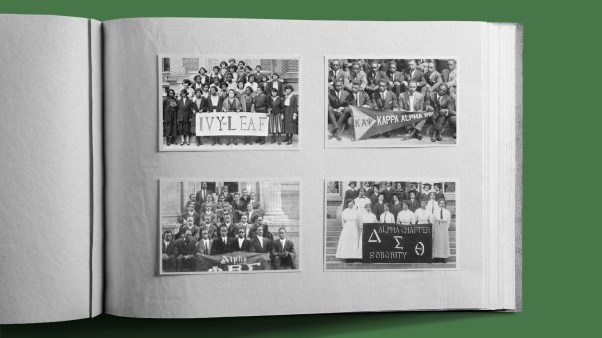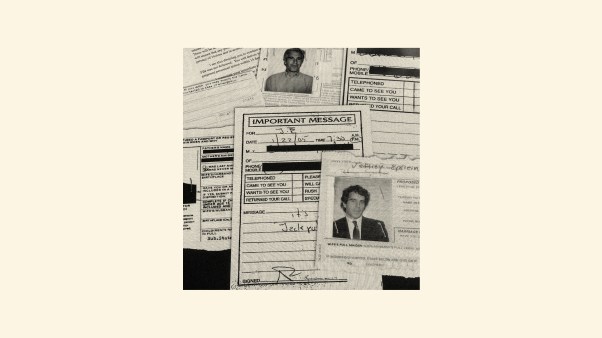Save for Jesus Christ and his mother Mary, few biblical figures hold more prominence in the history of Christian art than Mary Magdalene. Paintings and sculptures favor depicting these two Marys not just because they appear frequently in the New Testament but because they play such pivotal roles in the life of Jesus.
Of course, Mary of Nazareth’s identity is uncontested. She is the young betrothed woman who conceived Jesus, God’s Son, and was present with her Son and his followers at various times throughout his earthly ministry, enduring to the end and beyond, when the Holy Spirit compelled the faithful to spread the news of his salvation.
However, the identity of Mary Magdalene has not been so clear. When we track her visual depictions across time, a richly complex and intriguing story emerges that ultimately raises a central question: Who was Mary Magdalene?
When Christian art directs our attention to this Mary, we quickly realize that there is no straight answer. As Diane Apostolos-Cappadona’s latest visual history reveals, Mary Magdalene has been many things to the church worldwide throughout the ages.
In fact, the 2002 exhibit “In Search of Mary Magdalene,” curated by Apostolos-Cappadona, featured over 80 works of art and objects depicting Mary Magdalene. Repeated patterns within art history associate her with long hair, an anointing jar, and nudity. She is depicted as the epitome of a penitent sinner and reformed prostitute, renowned for her fervent love of Christ and humility before him. She is recognized for her place at the cross and at the tomb in the garden; she is also remembered for her courageous missionary journeys as an evangelist and preacher.
Mary Magdalene’s portrayal gives insight into the church’s tradition of interpreting her story in the biblical text and the impact of medieval legends.
The Art Institute of Chicago recently hosted two paintings by the renowned Italian artist Caravaggio. One of them, Martha and Mary Magdalene (painted around 1598), illustrates the difficulties of discerning Mary Magdalene’s story.
In pairing Mary Magdalene with Martha, Caravaggio was following the sixth-century teachings of Pope Gregory the Great, who absorbed Mary of Bethany’s biblical references into the person of Mary Magdalene. At Gregory’s direction, Martha became Mary Magdalene’s sister and Lazarus became her brother in the medieval mind. By Caravaggio’s time, exegetical moves to distinguish Mary of Bethany from Mary Magdalene had developed into a Reformation-era controversy between Protestants and Roman Catholics. Were there two Marys in these passages or one? As Margaret Arnold’s work has shown, tensions between church tradition and sola Scriptura played out with Mary Magdalene.
Probing Caravaggio’s painting reveals another layer of complexity. Mary Magdalene looks into a convex mirror, which was a luxury item in the early modern period. Though we are overly familiar in today’s world with encountering our own reflections, that was not people’s experience then. Mirrors did not become household items until the 17th century; they didn’t begin replacing wall tapestries until the 18th century. Meanwhile, the convex mirror was associated with the distortion of the self, a reference to self-perception and the need to come to grips with human sin.
By pairing Mary Magdalene with a convex mirror, Caravaggio elicits themes of sin and penance, which had framed her story for centuries due to her association with the sinful woman of Luke 7. The conflation happens in this way: Mary Magdalene and Mary of Bethany are joined as one, and then the similarities in the anointing accounts—John 12:1–8, where Mary of Bethany anoints Jesus, and Luke 7:36–50, where an unnamed sinful woman anoints Jesus—cast this reputation of sinfulness upon Mary Magdalene.
Remembering Mary Magdalene rightly is no simple endeavor. Artistic images often reflect the confusion of traditional readings of the biblical text as well as layers of medieval legends that extended her story.
A more contemporary example: The multiseason series about Jesus’ life by Dallas Jenkins, The Chosen, rapidly generated buzz from its first episode simply by introducing the life of Jesus through two unlikely and often overlooked figures: Mary Magdalene and Nicodemus.
The growing interest in considering Mary Magdalene’s identity and significance should lead us to look again at the biblical text. She may not appear on every page in the Gospel accounts, but in the multiple times she does, she holds a prominent place as an eyewitness and recipient of grace.
 Illustration by Chloe Cushman
Illustration by Chloe CushmanThe New Testament record creates a compelling picture of Mary Magdalene’s life and faith. Luke introduces her in this way:
Soon afterwards [Jesus] went on through cities and villages, proclaiming and bringing the good news of the kingdom of God. The twelve were with him, as well as some women who had been cured of evil spirits and infirmities: Mary, called Magdalene, from whom seven demons had gone out, and Joanna, the wife of Herod’s steward Chuza, and Susanna, and many others, who provided for them out of their resources. (Luke 8:1–3, NRSV throughout)
Luke distinguishes her from the many other Marys as the one called “Magdalene.” Often, scholars had associated this title with a thriving fishing village on the west side of the Sea of Galilee, purportedly named Magdala for a tower present at its port in an earlier era (magdala means “tower” in Aramaic). People—and wealth—flowed in, promoting the area from a village to a true polis, a Jewish rival to the cities of the Decapolis. Recent archaeological discoveries have unearthed an affluent synagogue and Hellenistic baths.
Given what Luke says about Mary’s generosity, if she hailed from here, she was likely one of the people who benefitted from its wealth.
Despite her material bounty, however, her life experience also included a period of oppression. Because Mary is following Jesus, and since the Gospel writers are keen to show that Jesus is especially powerful in the skill of exorcism, it follows that he likely cast out the demons from her. She, along with the other women who were traveling with him, had been healed from various maladies, both spiritual and physical.
In another instance in Jesus’ ministry when those healed wanted to go with him, he refused. He sent them back to their homes (Luke 8:38–39; 14:4). But to these many women, he had said yes.
The extent of Mary Magdalene’s healing sets her apart. In his teaching elsewhere, Jesus describes a person with seven spirits to exemplify a desperate situation (Luke 11:26).
A number of completion, seven indicates that the demons had invaded Mary’s whole life. If the encampment of one spirit brings terror, seven would be nearly unimaginable. Mary stands, then, as an example of one to whom much has been given in her healing. Consequently, of her much is required (12:48).
She amply fulfills her debt of gratitude to Jesus. As he is traveling through the cities and the villages preaching the good news about the kingdom of God, she is there with him, and she is the first among the named women. This is one of the clear places in the New Testament where our vision of Jesus’ followers is expanded to include more than the 12 disciples. They are there, but they are not the only ones. The circle is wider.
To show their gratefulness, Mary and the other women serve the Jesus movement out of their possessions. If anyone ever wondered how Jesus and his 12 disciples survived when they had left their jobs, this is part of the answer. These women helped pay the bills. Over the course of his many travels, they bankrolled, observed, and participated in his ministry.
Readers might expect Luke to mention them because he has a tendency to indicate the presence of women alongside men (Luke 23:27, 49), but Matthew and Mark also point out the mixed-gender group of followers. Both Evangelists mention the women who followed Jesus from Galilee to Jerusalem, ministering to him on that lengthy journey (Matt. 27:55–56; Mark 15:40–41).
In all three references, Mary Magdalene is mentioned first. She was one of Jesus’ longtime and deeply committed followers. She had a story to tell about what her Lord had done for her. Because she continued to follow Jesus through the end of his life, her eyewitness account included the events that changed the world. She was present to observe his death, burial, and resurrection.
Matthew, Mark, and Luke indicate that a group of women stands watching at a distance when Jesus is crucified (Luke 23:49; 24:10). Mary Magdalene’s name appears first in both Matthew’s and Mark’s lists of the women. While they have neither fled nor denied Jesus as some of the other disciples have, watching from afar would not afford Jesus any comfort. Interpreters have wondered if the Evangelists are evoking Psalm 37:12 in the Septuagint (Psalm 38:11 in our Bibles), where a sufferer’s difficulty is compounded when his friends and family keep their distance.
According to John’s account of the Crucifixion, however, Mary does not stay in that location: “Meanwhile, standing near the cross of Jesus were his mother, and his mother’s sister, Mary the wife of Clopas, and Mary Magdalene” (John 19:25, emphasis added).
At some point, she moves from a distance to be near Jesus, near enough that she can hear him speak. Since he is being crucified as a pretender to the throne, being associated with him can come with some cost. We know that early Christian women were imprisoned and persecuted for their faith—Romans 16:7 mentions Junia’s ordeal, and a second-century letter from the Roman governor Pliny to Emperor Trajan mentions two female deacons who were questioned and tortured. Mary is bold enough to risk being present to comfort Jesus as well as his mother.
All the Gospels indicate that Mary continues to be present after Jesus dies. She follows the short distance from the cross to the tomb to see where Jesus’ body is laid (Luke 23:55). She is willing to watch what is often the most difficult part of a loss: the moment when death seems final, the placing of the person into their resting place, when dust returns to dust.
After honoring the rest of the Sabbath, Mary and the other women return to that tomb so they can anoint Jesus’ body with perfume and spices. To anoint a corpse with oil was common, but spices indicated something special. It seems that Mary and the other women who had been providing for Jesus financially continued to do so, along with Nicodemus (John 19:39). Readers see the deep commitment of those who were willing to do this task.
In being willing to care for him for that final time, Mary and the other women witness the most definitive moment of Jesus’ human life. When they return to the tomb, they do not find Jesus’ body. Instead, heavenly beings in dazzling white comfort them in their shock, remind them that Jesus had predicted just this event, and compel them to go tell the other disciples the news of his resurrection (Matt. 28:5–7; Mark 16:6–7). Then Jesus himself meets them in his resurrected state and commissions them to proclaim this to the other followers (Matt. 28:10).
Mary Magdalene is the only one of these women named in all four Gospel accounts, which means that every Evangelist believed she was important enough to include by name. Mary was present with Jesus in his ministry, death, and resurrection, and he told her to tell that story. For this reason, she has been remembered in Eastern and Western Christianity as the first apostle.
Mary Magdalene’s witness to the tomb and beyond speaks of God’s immense redemptive power that delivered her from seven demons. She also testifies to God’s sustaining power, which she accepted, to grant her the faithful ministry of presence throughout key moments of Jesus’ life. She was then faithful to proclaim the world-changing good news about him, having been commissioned by Jesus himself to do so.
In fact, in Luke’s sprawling narrative of the birth of the church, Mary Magdalene seems to be included among those who are commissioned to tell the Good News, not only to the other disciples but also to all people. In Luke 24:33, the 11 disciples and their companions are gathered, which would include Mary Magdalene and the other women who have returned to testify to his resurrection (vv. 9–10). Then Jesus appears and says to them all, “You are witnesses of these things” (v. 48).
Witnesses are people who have seen so that they can tell. Jesus instructs them to wait for the coming of the Spirit, which Luke makes clear falls upon both male and female servants of Jesus (Acts 2:17–18). When describing the post-Resurrection events in his sermon at Antioch of Pisidia, Paul summarizes, “For many days he appeared to those who came up with him from Galilee to Jerusalem, and they are now his witnesses to the people” (Acts 13:31, emphasis added).
Because Mary came up with him from Galilee to Jerusalem—because he appeared to her resurrected—she is now one of his witnesses to the people.
Her consistent faithfulness might very well be reflected in her name. Recent conversations among New Testament scholars, propelled by the work of Elizabeth Schrader Polczer, have wondered if “Magdala” describes not her hometown but instead her character. She is a tower of the faith, steadfastly pointing the way to the one who delivered her and gave her a mission. The church too has recognized the significance of her name in this way, though this has not always been remembered.
God gives all followers of Jesus the challenge to embrace the power of the Spirit to emulate Mary’s faithfulness in both deed and word. Once again, the revelation of Scripture declares to us that God does not intend to work in this world to the exclusion of women.
The prevalence of her depiction in Christian art displays both an appreciation of the pivotal role she plays as well as some of the confusion about her identity. The Bible never names the nature of the demons who afflict her or the nature of the sin of the unnamed woman in Luke 7 with whom she has been associated. To think of her as a prostitute is to read into and beyond the biblical text.
But Caravaggio’s mirror is not wrong. She was caught in the web of sin, afflicted without and within by the powers of darkness—as are we all—and in need of the Savior, Jesus Christ.
Despite the confusions through the centuries, the answer to the question “Who was Mary Magdalene?” is clear. She is a redeemed sinner whom the Spirit of God empowered to follow Jesus and whom Jesus himself commissioned to tell the good news of his return to life on Easter morning.
As we encounter her image, let us use it as a mirror to see ourselves and what we, by God’s gracious power, can become: apostles, sent to tell the good news of the Resurrection.
Jennifer Powell McNutt is the Franklin S. Dyrness Chair of Biblical and Theological Studies at Wheaton College and the author of The Mary We Forgot (Brazos Press, October 2024).
Amy Beverage Peeler is the Kenneth T. Wessner Chair of Biblical Studies at Wheaton College and the author of Women and the Gender of God.













